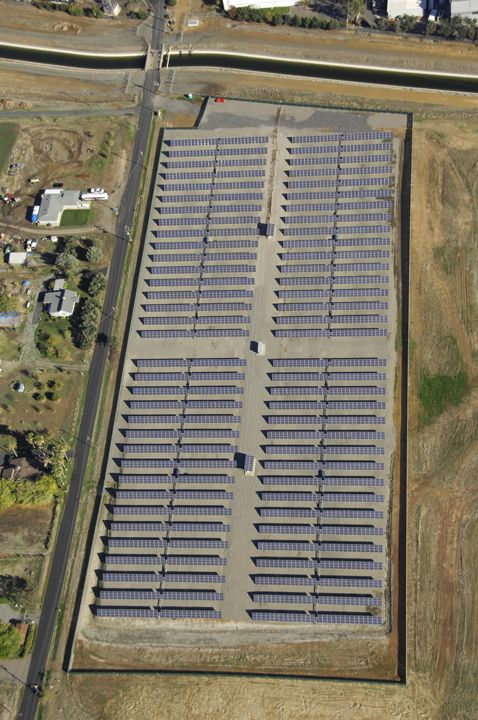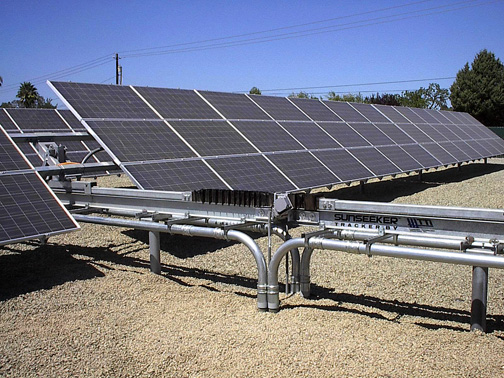Back Issues
 Following the Sun Looking for a system that generates optimum power-and return on investment-ALZA Corporation opted for a solar PV array system for its Northern California plant that follows the sun's changing angle during the day and generates up to 20 percent more electricitythan a fixed-tilt system. By Vicky Boyd When officials with the pharmaceutical manufacturer ALZA Corporation contemplated installing a 1 MW solar power generation system on land adjacent to its Northern California plant, they looked beyond the environmental benefits of just reducing greenhouse gas production. They also considered how the system would create a buffer between the plant and neighboring residential areas and how it would help protect water quality in a nearby creek, compared with other uses for which the land was zoned. "We had a permit that allows us to put in a parking lot. But when we looked at it, it's certainly not something that's desirable for the residential area because it brings in more traffic,"says Erol Odabasi, ALZA environmental manager based in Vacaville. "The lot also creates storm water issues near a wetland area, so the solar project seemed ideal since it wouldn't harm the wetlands and wouldn't disturb the neighbors." The ground-mounted photovoltaic system, which was dubbed SPF-1,000 (Solar Panel Farm-1,000 kW) internally, will offset about 18,000 tons of carbon dioxide emissions over its 25-year expected life. And that will go towards helping ALZA's parent company, Johnson & Johnson, reach its 2010 goal of reducing greenhouse gas emissions by seven percent of 1990 levels, Odabasi says. The 1 MW solar generation system at the Vacaville plant produces about one-third of the plant's peak electricity demands during the summer. Located about half way between San Francisco and Sacramento, California, the ALZA pharmaceutical manufacturing facility has about 900 full-time employees and operates around the clock. Throughout the United States, New Brunswick, New Jersey-based Johnson & Johnson has nine solar-generation systems totaling 4.1 MW, making it the second largest corporate user of on-site solar energy in the country, according to the World Resources Institute. In addition to Vacaville, Johnson & Johnson also has a 1 MW system on its Neutrogena plant in Los Angeles and a 500 kilowatt system on ALZA's research and development facility in La Jolla. The company's seven remaining solar-generation systems are in New Jersey and Pennsylvania. ALZA officials started looking at solar generation for the Vacaville plant in 2005. At the same time, the company was continuing its long-term plan to improve overall energy efficiency. Among the improvements have been the installation of a variable-speed drive on the chiller, thermo-recovery systems, energy efficient lighting upgrades and motion detectors to turn off lights when rooms are vacant. And ALZA still has several other improvements on its to-do list, Odabasi says. Although the modifications represent significant energy savings, he says they aren't as visible to employees and the community and aren't as "sexy" as the solar project. From the beginning, ALZA officials focused on a ground-mount system instead of roof-mount, Odabasi says. The company owned about seven acres of vacant land adjacent to the plant that would be a nearly ideal location for the panels. "There are a lot of penetrations on the roof because we are a manufacturing facility, and they'd get in the way of a roof-mount," he explains. "We are continually doing some sort of project because new production comes and goes. A ground-mount system has higher efficiency and less future maintenance issues, so it seemed to make more sense." Like any capital improvement proposed by a Johnson & Johnson company, ALZA's solar project had to be analyzed for return on investment, Odabasi says. Because energy projects don't always meet the ROI criteria when competing with other capital projects, J & J has set aside $40 million to help augment capital financing so the projects can be built. Even then, the energy projects may be a hard sell, Odabasi says. "Although the project provided an internal rate of return of 11 percent, we really had to use other methods to justify the project other than financial standards alone. We had to partner with a lot of other groups." Among those was the California Public Utilities Commission (PUC), which through the California Solar Initiative currently offers rebates that start at $2.50 per watt for commercial generation systems up to 1 MW, and ALZA was able to receive $3 per watt for SPF-1,000. The rebates are limited to projects of 1 MW or less, which was the main reason why ALZA officials decided upon a 1 MW system, Odabasi says.  The PV arrays are mounted on SunSeeker single-axis solar tracker systems that follow the sun's changing angle throughout the day. The SunSeeker systems are manufactured by Thompson Technology Industries, a sister company to SPG Solar Inc., which built the project. In addition, ALZA officials took advantage of another PUC-administered program-the Self Generation Incentive Plan-that offers financial incentives to customers who install certain types of generation equipment. ALZA also was eligible to receive a 30 percent tax credit from the federal government. In New Jersey, Johnson & Johnson has been able to sell solar renewable energy certificates, which generate additional revenue, says Odabasi, who worked in New Jersey before being transferred to California. Each time a solar electric system generates 1 MW hour of electricity, New Jersey's Clean Energy Program issues an SREC (Solar Renewable Energy Credit), which can then be sold or traded separately from the power. But he says energy credit trading hasn't advanced to that point in California. Once the Vacaville project received internal approval, Odabasi says it was put out for bid. At the time, the 1 MW project would have been one of the largest privately-owned commercial installations in California. So ALZA officials sought companies that had experience installing large-scale solar projects. SPG Solar Inc., a Novato, California-based solar design, engineering and installation firm, was one of three companies that submitted proposals. "Based on their proposal, we felt like they had what it took to do the project for us," Odabasi says. The project involved 5,740 Sharp 208-watt solar panels and two SatCon 500 kW inverters. Rather than being in a fixed position, the PV arrays are mounted on SunSeeker single-axis solar tracker systems that follow the sun's changing angle throughout the day, says Steve McKenery, vice president of commercial development for SPG, which is based in San Diego, California. Manufactured by SPG Solar's sister company, Thompson Technology Industries Inc., the patent-pending SunSeeker systems can be used with any manufacturer's PV panels, McKenery says. In the morning, the panels start out at 45 degrees facing east. By evening, the panels are at 45 degrees facing west. Before the start of the next day, they return to 45 degrees east. Each centrally mounted five-horsepower electric motor can handle up to 350 kW of panels. In ALZA's case, the panels are divided into four quadrants, with one motor handling about 250 kW. A global positioning system helps guide the continuous adjustments. Every two to three minutes, the motor turns a screw drive for a few seconds that moves the panels "ever so slightly," McKenery says. "The electrical consumption of those four motors costs only pennies a day," he adds. By tracking the sun's angle, the panels generate 15 percent to 20 percent more electricity than a fixed-tilt system of the same size, McKenery says. "It costs one to two percent more to build and you get 15 to 20 percent more power-it's a no-brainer financial exercise," he adds. If winds exceed 30 miles per hour, the Storm Watch sensor automatically stores the modules horizontally. Dual-axis tracking systems, where the panels not only track from east to west but also north to south, are also available. But those systems only generate three percent to four percent more electricity than the single-axis tacking system and cost considerably more, McKenery says. "So the extra cost and the complexity of tracking north to south and east to west really isn't worth it," he adds. The DC current from the ALZA panels is fed into the two inverters, which convert it to AC and step it up to 12,000 volts. Cables then carry it about a half mile to the plant. The land on which the panels sit is relatively flat. So the actual design and building was "pretty straightforward" McKenery says. Security at the site is controlled by the same system that is used throughout the rest of the manufacturing site, but includes additional security fencing around the solar generation system The system went on line in October 2007, and ALZA officials dedicated it in December 2007. The region in which the plant is located historically has several days of thick winter fog each year that potentially could reduce power generation. But Odabasi says that was not the case this past winter. "It's actually exceeding our expectations at this time of year, so we are very happy with this performance," he says. "We haven't gone through a full summer, but we expect it to meet what we had planned for." May/June 2008 |








